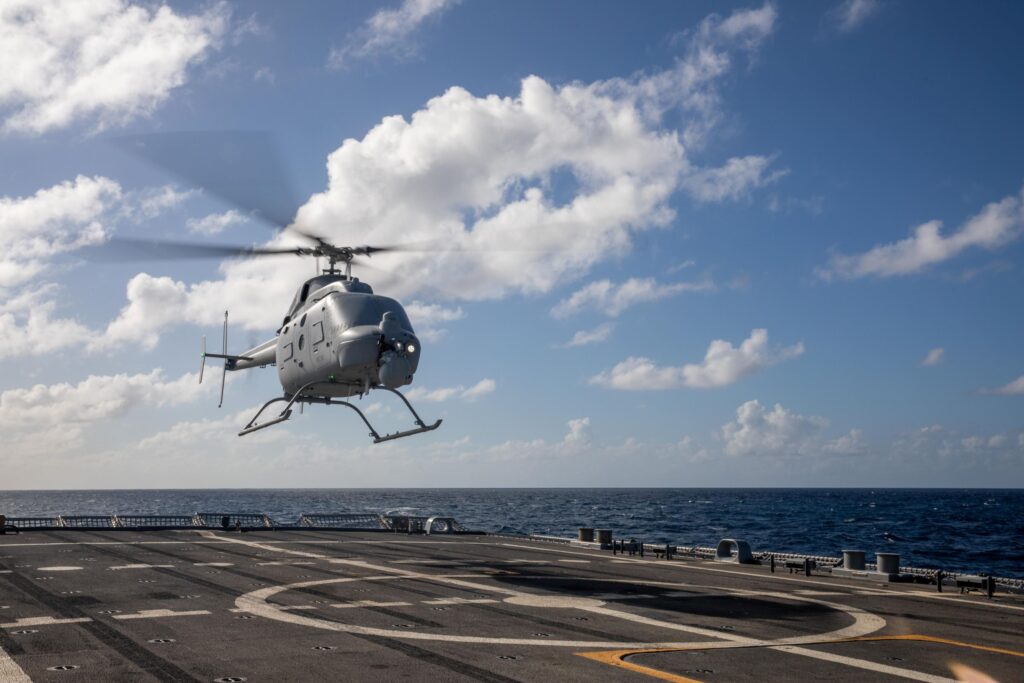
ARLINGTON, Va. — The Navy has deployed the MQ-8C version of its Fire Scout unmanned helicopter for the first time but waited five weeks to make the announcement.
An MQ-8C, built by Northrop Grumman, was deployed operationally on Dec. 14 on board the Freedom-class littoral combat ship USS Milwaukee (LCS 5), the Navy and Northrop Grumman announced in Jan. 24 releases.
The deployment was apparent before Jan. 24 in a series Navy photographs taken Jan. 6 while the MQ-8C was operating from the USS Milwaukee in the Caribbean Sea. The ship was deployed in the U.S. 4th Fleet’s area of operations in support of Joint Interagency Task Force South’s mission, which includes counter-illicit drug trafficking missions in the Caribbean and Eastern Pacific, according to the caption.
The Milwaukee had departed Naval Station Guantanamo Bay, Cuba, on Jan. 3 after two weeks in port following an outbreak of the COVID-19 virus in the crew.
The MQ-8C was being operated by the “Sea Knights” of Helicopter Sea Combat Squadron (HSC) 22, Detachment 5. The squadron also operates the MH-60S Seahawk manned helicopter and is using both aircraft in counter-narcotics operations.
The Fire Scout “will identify targets of interest and refine surveillance data of existing targets of interest, allowing for enhanced capabilities for counter illicit drug trafficking missions,” the Navy said in a release.
“This is a significant milestone in the MQ-8C Fire Scout program,” said Navy Capt. Eric Soderberg, the Navy’s Fire Scout program manager. “The transition from the MQ-8B to the MQ-8C Fire Scout has brought improved sensors and more than doubles the on-station endurance. Advances in Fire Scout’s capabilities further our successful integration of unmanned platforms at sea and the Navy and Marine Corps unmanned campaign plan.”
“Our partnership with the U.S. Navy has been critical in developing Fire Scout’s multi-mission autonomous capabilities which provide greater situational awareness to the joint force,” said Lance Eischeid, director, Fire Scout program, Northrop Grumman. “With the ability to operate from a range of surface ships, MQ-8C Fire Scout is a powerful platform that allows the U.S. Navy to increase the detection and tracking of targets through its onboard sensors and integration with manned assets.”
“Fire Scout is a force multiplier, not only in our current mission, but in every mission the U.S. Navy conducts,” said Cmdr. Brian Forster, commanding officer of Milwaukee. “I am very excited of the team I have onboard which has already, and will continue to, demonstrate how manned and unmanned assets can work together to effectively achieve the mission.”
In December, an MQ-8C was photographed on the deck of Independence-class littoral combat ship USS Jackson (LCS 6) while in port in Apra Harbor, Guam. The caption stated the Jackson was part of Destroyer Squadron Seven “on a rotational deployment in the U.S. 7th Fleet area of operation to enhance interoperability with partners and serve as a ready-response force in support of a free and open Indo-Pacific region.”
The MQ-8C in the Guam photograph was going through pre-deployment functional ground checks for a detachment of Helicopter Sea Combat Squadron 23 — based at Naval Air Station North Island, California — that will operate the MQ-8C from the USS Jackson.
The MQ-8C, which achieved initial operational capability in June 2019, is an upgrade to the Fire Scout System mainly in that it uses a Bell 407 airframe, which is larger than the earlier-design MQ-8B’s airframe and equipped with more powerful engines, thus having a greater speed, payload and endurance, up to 10+ hours of endurance on station and a range of more than 1,000 nautical miles.
The MQ-8C is equipped with the Leonardo ZPY-8 Osprey search radar or an electro-optical/infrared sensor and uses the same ground control station and the MQ-8B. The Navy plans to add more capability in the form of Link 16 data link, passive targeting, and a mine-countermeasures payload.
Northrop Grumman was under contract to deliver 38 MQ-8Cs, all of which have been delivered and will replace the earlier MQ-8B version, of which 30 have been delivered to the fleet.
- BlueHalo to Test C-UAS System on Marine Corps JLTV - April 29, 2024
- USS George Washington Deploys to U.S. Southern Command, Eventually Headed to Japan - April 26, 2024
- SECNAV Advocates Increased Legal Immigration to Increase Shipbuilder Workforce - April 23, 2024



